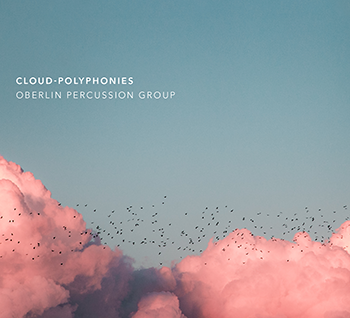by Mike Telin

Joining that esteemed group of pieces is James Wood’s Cloud-Polyphonies. Premiered on November 4, 2011 by the Oberlin Percussion Group — Edward Atkinson, Ben Bacon, Sean Dowgray, Isaac Fernandez Hernandez, Jake Harkins, and Neil Ruby under the direction of Michael Rosen — the work was recorded one week later in Clonick Hall. That recording has now been released on the Oberlin Music label.
The sextet was commissioned by Rosen on behalf of Oberlin Conservatory in 2009 when he and Wood were serving on the jury of the Geneva Competition. In addition to Oberlin, the project included more than a dozen co-commissioners including the Yale School of Music and the New England Conservatory.
Utilizing over 150 different instruments (click here for player instructions and composer notes), Cloud-Polyphonies immediately encapsulates nature with “Starlings.” Featuring marimbas and woodblocks, Wood’s music depicts the agile small birds as they gather and disperse, and Rosen and his players magically capture their nimble flights of fancy.
The second movement, “Clouds,” recalls the composer’s experience of taking a hot air balloon ride over the English countryside. In his notes, Wood says that the pilot explained that active clouds (cumulus, or cumulus congestus) build and become powerful and often dangerous, while passive clouds (cirrus) appear harmless but should be watched, as they could quickly become active. The music transitions seamlessly from one state to another and back again using an array of metal instruments along with prepared and bowed piano. Here Rosen’s astute pacing holds the listener’s attention throughout the movement’s 18-minute duration.
A total of 66 drums are needed for the concluding “Buffalo.” Again, the music captures nature as pounding hooves make their way across the North American plains. The Oberlin Percussion Group vividly brings the large animals to life. Chamber music at its best, Cloud-Polyphonies is a must-have for any percussion ensemble discography.
The album was produced, edited, mixed, and mastered by Paul Eachus, with audio engineering by Ryan Miller.
Published on ClevelandClassical.com August 11, 2020.
Click here for a printable copy of this article



